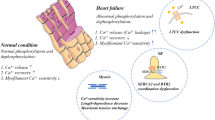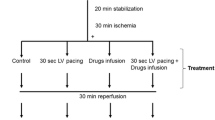Abstract
Human hibernating myocardium (HHM) is characterized by reversible contractile dysfunction during chronic ischemia. A disturbed calcium-homeostasis is a decisive factor for reduced functional capacity in heart diseases. We therefore investigated calcium-handling proteins in HHM. In 12 patients suffering from multi-vessel coronary artery disease and contractile dysfunction with indication for bypass surgery, HHM was detected preoperatively by thallium scintigraphy, radionuclide ventriculography and dobutamine echocardiography. Transmural biopsies of these regions were taken and analyzed by immunohistochemistry and electron microscopy. Furthermore, SR-calcium ATPase (SERCA2a), phospholamban (PLN), the phosphorylated forms of PLN (PLN-Ser16, PLN-Thr17) as well as sodium-calcium exchanger (NCX) and ryanodine receptor (RyR2) were investigated by RT-PCR and Western-blotting. Additionally, SERCA2a activity was measured by an enzyme-coupled assay. In all patients complete functional recovery could be documented 3 months after revascularization by repeating all preoperative investigations. In HHM maximal SERCA2a activity was significantly reduced (HHM: 424.5± 33.9, control: 609.0± 48.5 nmol ATP mg protein−1 min−1, p≤ 0.05), whereas SERCA2a protein levels were unchanged. mRNA levels (HHM: 1.36± 0.08 vs. control: 0.78± 0.04, p≤ 0.05) and protein amount (HHM:1.67± 0.14 vs. control: 1.00± 0.04, p≤ 0.05) of PLN (A1) were increased resulting in an increased PLN:SERCA2a-ratio. PLN-Ser16 (HHM: 0.60± 0.08 vs. control: 1.00± 0.11, p≤ 0.05) and PLN-Thr17 (HHM: 0.63± 0.11 vs. control: 1.00± 0.06, p≤ 0.05) phosphorylation was significantly decreased. RyR2 and NCX showed no significant alteration. In HHM a decreased activity of SERCA2a due to an impaired phosphorylation of PLN contributes to contractile dysfunction. The increase in the relative ratio of PLN/SERCA2a leads to a decreased calcium affinity of SERCA2a.
Similar content being viewed by others
References
Rahimtoola SH: The hibernating myocardium. Am Heart J 117: 211–221, 1989
Elsässer A, Schlepper M, Klovekorn WP, Cai WJ, Zimmermann R, Muller KD, Strasser R, Kostin S, Gagel C, Munkel B, Schaper W, Schaper J: Hibernating myocardium: An incomplete adaptation to ischemia. Circulation 96: 2920–2931, 1997
Borgers M, Ausma J: Structural aspects of the chronic hibernating myocardium in man. Basic Res Cardiol 90: 44–46, 1995
Hasenfuss G, Meyer M, Schillinger W, Preuss M, Pieske B, Just H: Calcium handling proteins in the failing human heart. Basic Res Cardiol 92(Suppl 1): 87–93, 1997
Luss H, Schafers M, Neumann J, Hammel D, Vahlhaus C, Baba HA, Janssen F, Scheld HH, Schober O, Breithardt G, Schmitz W, Wichter T: Biochemical mechanisms of hibernation and stunning in the human heart. Cardiovasc Res 56: 411–421, 2002
Deindl E, Neubauer E, Elsasser A, Zimmermann R, Schaper W: Reduced contractile function characteristic of hibernating human heart is not mediated by phospholamban. Ann N Y Acad Sci 853: 270–272, 1998
Elsässer A, Müller KD, Vogt A, Strasser R, Gagel C, Schlepper M, Klövekorn WP: Assessment of myocardial viability: Dobutamine echocardiography and thallium-201 single-photon emission computed tomographic imaging predict the postoperative improvement of left ventricular function after bypass surgery. Am Heart J 136: 463–475, 1998
Schwinger RH, Bohm M, Schmidt U, Karczewski P, Bavendiek U, Flesch M, Krause EG, Erdmann E: Unchanged protein levels of SERCA II and phospholamban but reduced Ca2+ uptake and Ca(2+)-ATPase activity of cardiac sarcoplasmic reticulum from dilated cardiomyopathy patients compared with patients with nonfailing hearts. Circulation 92: 3220–3228, 1995
Chu A, Dixon MC, Saito A, Seiler S, Fleischer S: Isolation of sarcoplasmatic reticulum fractions referable to longitudinal tubules and junctional terminal cisternae from rabbit skeletal muscle. Methods Enzymol 157: 36–46, 1988
Chomczynski P, Sacchi N: Single step method of RNA isolation by acid guanidinium thiocyanate-phenol-chloroform extraction. Anal Biochem 162: 156–159, 1987
Elsässer A, Schlepper M, Zimmermann R, Muller KD, Strasser R, Klovekorn WP, Schaper J: The extracellular matrix in hibernating myocardium – A significant factor causing structural defects and cardiac dysfunction. Mol Cell Biochem 186: 147–158, 1998
Arai M, Matsui H, Periasamy M: Sarcoplasmic reticulum gene expression in cardiac hypertrophy and heart failure. Circ Res 74: 555–564, 1994
Schwinger RH, Brixius K, Bavendiek U, Hoischen S, Muller-Ehmsen J, Bolck B, Erdmann E: Effect of cyclopiazonic acid on the force–frequency relationship in human nonfailing myocardium. J Pharmacol Exp Ther 283: 286–292, 1997
Luo W, Wolska BM, Grupp IL, Harrer JM, Haghighi K, Ferguson DG, Slack JP, Grupp G, Doetschman T, Solaro RJ, Kranias EG: Phospholamban gene dosage effects in the mammalian heart. Circ Res 78: 839–847, 1996
Wolska BM, Stojanovic MO, Luo W, Kranias EG, Solaro RJ: Effect of ablation of phospholamban on dynamics of cardiac myocyte concentration and intracellular calcium. Am J Physiol 271: C391–C397, 1996
Brittsan AG, Carr AN, Schmidt AG, Kranias EG: Maximal inhibition of SERCA2 Ca(2+) affinity by phospholamban in transgenic hearts overexpressing a non-phosphorylatable form of phospholamban. J Biol Chem 275: 12129–12135, 2000
Kiss E, Brittsan AG, Edes I, Grupp IL, Grupp G, Kranias EG: Thyroid hormone-induced alterations in phospholamban-deficient mouse hearts. Circ Res 83: 608–613, 1998
Gwathmey JK, Copelas L, MacKinnon R, Schoen FJ, Feldman MD, Grossman W, Morgan JP: Abnormal intracellular calcium handling in myocardium from patients with end-stage heart failure. Circ Res 61: 70–76, 1987
Colyer J, Wang JH: Dependence of cardiac sarcoplasmic reticulum calcium pump activity on the phosphorylation status of phospholamban. J Biol Chem 266: 17486–17493, 1991
Sham JS, Jones LR, Morad M: Phospholamban mediates the beta-adrenergic-enhanced Ca2+ uptake in mammalian ventricular myocytes. Am J Physiol 261: H1344–H1349, 1991
Koss KL, Kranias EG: Phospholamban: A prominent regulator of myocardial contractility. Circ Res 79: 1059–1063, 1996
Wegener AD, Simmerman HK, Lindemann JP, Jones JR: Phospholamban phosphorylation in intact ventricles: Phosphorylation of serine 16 and threonine 17 in response to beta-adrenergic stimulation. J Biol Chem 264: 11468–11474, 1989
Munch G, Bolck B, Karczewski P, Schwinger RH: Evidence for calcineurin-mediated regulation of SERCA 2a activity in human myocardium. J Mol Cell Cardiol 34: 321–334, 2002
Borgers M, De Nollin S, Thone F, Wouters L, Van Vaeck L, Flameng W: Distribution of calcium in a subset of chronic hibernating myocardium in man. Histochem J 25: 312–318, 1993
Heusch G, Schulz R, Rahimtoola SH: Myocardial hibernation – A delicate balance. Am J Physiol Heart Circ Physiol 288(3): H984–999, 2005
Thomas SA, Fallavollita JA, Suzuki G, Borgers M, Canty JM, Jr.: Dissociation of regional adaptations to ischemia and global myolysis in an accelerated Swine model of chronic hibernating myocardium. Circ Res 91: 970–977, 2002
Fallavollita JA, Jacob S, Young RF and Canty JM, Jr.: Regional alterations in SR Ca(2+)-ATPase, phospholamban, and HSP-70 expression in chronic hibernating myocardium. Am J Physiol 277: H1418–H1428, 1999
Luss H, Boknik P, Heusch G, Muller FU, Neumann J, Schmitz W, Schulz R: Expression of calcium regulatory proteins in short-term hibernation and stunning in the in situ porcine heart. Cardiovasc Res 37: 606–617, 1998
Bers DM: Cardiac excitation–contraction coupling. Nature 415: 198–205, 2002
Author information
Authors and Affiliations
Corresponding author
Rights and permissions
About this article
Cite this article
Nef, H.M., Möllmann, H., Skwara, W. et al. Reduced sarcoplasmic reticulum Ca2+-ATPase activity and dephosphorylated phospholamban contribute to contractile dysfunction in human hibernating myocardium. Mol Cell Biochem 282, 53–63 (2006). https://doi.org/10.1007/s11010-006-1171-7
Received:
Accepted:
Issue Date:
DOI: https://doi.org/10.1007/s11010-006-1171-7




